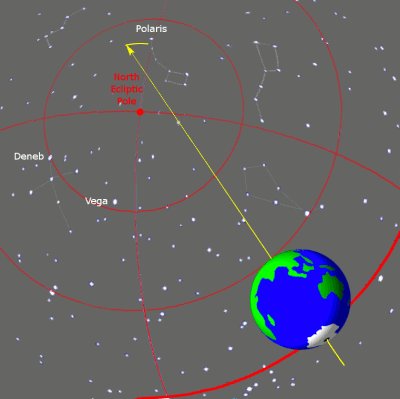16 years ago
Sidereal astrology differs from traditional astrology in that it projects real zodiacal constellations onto the ecliptic, rather than just dividing it into 12 parts, starting from the vernal equinox. In addition, the sidereal approach takes into account the phenomenon of precession, which was discovered by Hipparchus back in II century BC, and it invariably (from century to century) affects the shift of the star pattern that we see from Earth. The pictures below illustrate this clearly. Also in this article, I provide a set of parameters that I use for sidereal calculations.
2000 years ago, the ecliptic almost coincided with the celestial equator. But now the circumference of the solar orbit has shifted significantly:
 (click to view the full-size image)
(click to view the full-size image)
Astrologer Boris Fedotov:
«Officially, it is popularly believed that the first degree of Aries and the vernal equinox point continue to coincide. This is far from true. In January 1995, the British Royal Astronomical Society published a statement about the shift of the Earth's axis by 28°. This means that the Sun enters the Aries not on March 21, as was previously accepted, but on April 18. Therefore, we should renounce the established dogmas and accept the new, scientifically established coordinates of the Sun's movement».
How I do the calculation
Classical (Western) astrology uses the tropical zodiac, which starts from the vernal equinox. But I use the sidereal zodiac (also used in Vedic astrology), which takes into account the phenomenon of precession of the earth's axis. Specifically, I use the Djwhal Khul ayanamsha, which zodiacal signs correspond to the coordinates of real ecliptic constellations.
I calculate the coordinates of the planets and other celestial points based on Swiss Ephemeris taking into account universal time. By default, the ephemerides are adapted to the tropical zodiac. Since I need sidereal zodiac, I use parameters SEFLG_SIDEREAL and SE_SIDM_DJWHAL_KHUL in my calculations. This is the full list of the parameters:
- SweConst.SEFLG_SWIEPH - a sign of using the Swiss Ephemeris calculation by Astrodienst AG Zürich;
- SweConst.SEFLG_SPEED - a flag for recording the speed and retrograde motion of celestial bodies;
- SweConst.SEFLG_SIDEREAL - a flag for calculating sidereal positions of celestial bodies;
- SweConst.SEFLG_TRUEPOS - calculating the true position of celestial bodies, not apparent (without considering the time-light);
- SweConst.SEFLG_TOPOCTR - calculating coordinates based on the observer's location rather than the center of the Earth;
- SweConst.SE_SIDM_DJWHAL_KHUL - a constant representing the ayanamsha defined by Djwhal Khul (in my experience, it gives planetary positions closer to the truth)
For more information on how to make astrological calculations in the sidereal system, see the article from the Swiss Ephemeris documentation: 2.8. Sidereal Ephemerides for Astrology.
Astronomical Encyclopedia about the precession:

«You have probably watched a spinning top and noticed that its axis is never motionless. Under the influence of gravity, in accordance with the laws of rotational motion, the axis of the top moves, depicting a conical surface. The Earth is like a giant top. Its axis of rotation also rotates slowly, under the influence of the gravitational forces of the Moon and the Sun. The Earth axis depicts a cone with an angle of 23°50" around the axis of the ecliptic, as a result of which the pole of the world moves around the pole of the ecliptic in a small circle, making one revolution in about 26 thousand years. This movement is called precession.
The consequence of the precession is a gradual shift of the vernal equinox point towards the apparent motion of the Sun by 50,3’’ per year. For this reason, the Sun enters this point 20’ each year earlier, than it makes a full revolution in the sky.
As a result of precession, the pattern of the daily sky rotation changes slowly: the pole of the world was near the star α Draco about 4,600 years ago; now it is located near the North Star; γ Cepheus will become the new «north» star after 2000 years; Vega (α Lyra) will become the «north» star after 12000 years, which is currently 51° from the pole.
A change in the position of the equator of the celestial pole causes a change in the ecliptic coordinates. Therefore, when citing the coordinates of celestial bodies in astronomical catalogues, it is necessary to indicate the epoch - the moment in time for which the positions of the equator and the vernal equinox were adopted when determining the coordinate system.
The phenomenon of precession was discovered in II century BC by the Greek astronomer Hipparchus».
Related links:
- Sidereal Zodiac as the basis of scientific astrology
- Coordinates of the 13 constellations of the Zodiac
- Praecessio aequinoctiorum
- Zodiac
 Please wait
Please wait 

